
Publisher:
Bonnie King
CONTACT:
Newsroom@Salem-news.com
Advertising:
Adsales@Salem-news.com

~Truth~
~Justice~
~Peace~
TJP
Nov-30-2013 16:27

 TweetFollow @OregonNews
TweetFollow @OregonNews
New, Unpublished Facts Around the 1985 Death of American Primatologist Dian Fossey in Rwanda
Salem-News.comBernard De WETTER had regular contacts with Dian Fossey up until the brutal murder of the famous American primatologist.
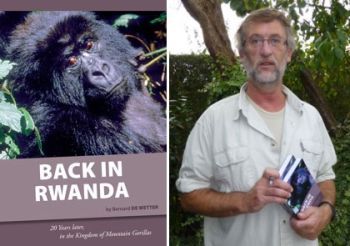 Order "Back in Rwanda" from Amazon.com |
(BRUSSELS) - “Back in Rwanda” - Was the famous American primatologist actually killed by poachers in the Virunga Forest in 1985?
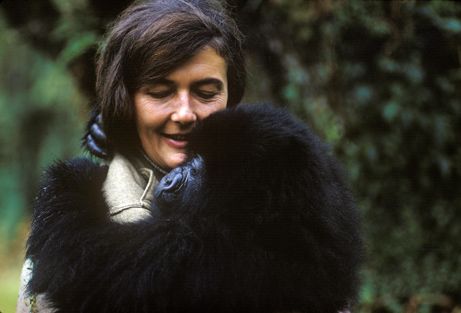 |
The author of the book, a Belgian naturalist who was working in Rwanda at the time, reveals unpublished facts and gives his own, different version about the murder.
Bernard De WETTER was in charge of anti-poaching operations in world-famous Volcanoes National Park during several years as from 1984.
From 2009 to 2011, he lived again in the Volcanoes area of Rwanda, this time as the manager of a high-end mountain lodge.
He had regular contacts with Dian Fossey up until the brutal murder of the famous American primatologist. While acknowledging the outstanding contribution of the extraordinary woman to the conservation of the mountain gorilla in the Virunga, he reveals other, less known aspects of her strong personality.
- Bernard De WETTER gives never-published – and surprising – information about events that took place short before and after the murder of the famous American primatologist, and which put the facts within a different context. He gives us his personal – and rather unexpected – view of the tragic event…
In a live and pleasant style, the author shares his encounters with mountain gorillas and other wildlife in the Virunga forest. He invites us into the « new » Rwanda he discovered upon his return, at a time when the aftermath of the civil war and genocide was still present in all memories. He takes us with him during his long patrols across the national park, in order to make us discover all aspects of the fight against poachers as it was taking place in the 1980’s…
The author refutes the official version of a murder by poachers. In the book, Bernard De WETTER relates details about the course of events that led to the incursion of “someone” in Dian Fossey’s cabin in the Virunga Forest in December 1985: someone intending to recover “something” of a great personal value… like the scientific reports of an American student?
BACKGROUND FILE
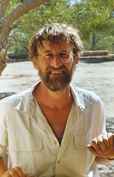
The Author
A Belgian-born naturalist, Bernard De WETTER has been professionally involved in wildlife conservation projects in all four corners of the world for more than two decades.
He was in charge of anti-poaching operations in Rwanda’s Volcanoes National Park as from 1984.
His activities have been focusing more specifically on wildlife tourism for the last few years: he helped develop structures and activities of respectful and sustainable nature tourism aimed at promoting the conservation of wildlife species and/or wilderness areas, mostly in Africa and Europe.
Bernard De WETTER is also a prolific author of numerous books on wildlife and nature topics (in his mother language, French). http://fr.wikipedia.org/wiki/
Dian FOSSEY
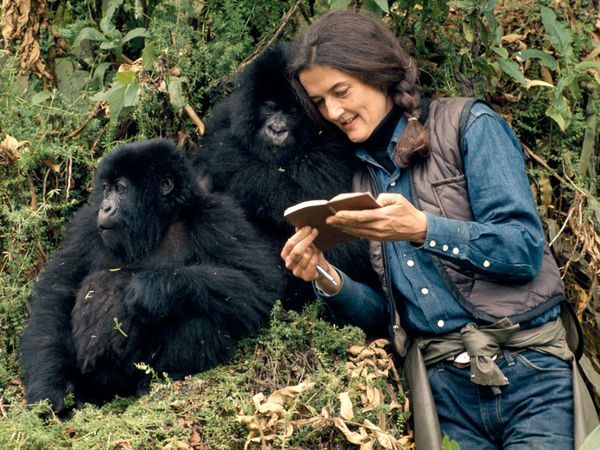 |
Born in the United States in 1932, Dian Fossey was initially a child therapist, who developed as from her childhood a strong interest in animals.
After a first personal trip across Eastern and Southern Africa, she wanted to be involved in the study and conservation of threatened African wildlife.
She was sent by famous anthropologist Louis Leakey to Eastern Congo in 1967, in order to study the mountain gorilla in the Virunga Volcano Range.
After civil war broke out in the country, she had to move to Volcanoes National Park, in neighboring Rwanda, where she founded her Karisoke Research Center.
For almost fifteen years, she courageously fought poaching, which was rampant in the park. Thanks to numerous press reports and film coverage, among others of the National Geographic Society, she brought the plight of the mountain gorilla to the attention of the world, and managed to curb down poaching. She lived at Karisoke Research Center, in the Virunga Forest, up to the day she was murdered, in December 1985.
The Mountain Gorilla
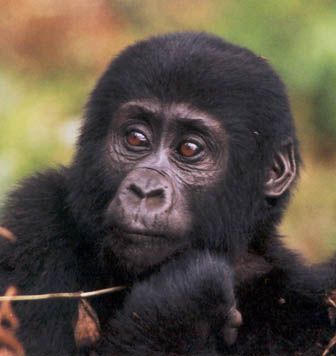 |
The Mountain Gorilla (Gorilla beringei beringei) is one of the two subspecies of the Eastern Gorilla currently existing, and it is probably the most famous of all gorilla subspecies. It was only discovered by Western Science in 1902, when German explorer Gustav von Bering shot two specimens in what is now Rwanda.
Today, there are only two sub-populations of the mountain Gorilla surviving: in the Virunga Forest (Rwanda, DRC, Uganda) and in Bwindi Forest (Uganda). The two subpopulations are separated from each other by a belt of cultivated land that is around twenty miles wide.
After a dramatic decline – primarily due to the progressive reduction of the forest available to the apes and, to a lesser extent, to poaching – mountain gorilla populations started to slowly increase as from the late 1970’s. Compared to an estimated population of around 250 individuals in 1981, the 2010 census operation of the Mountain Gorilla in the Virunga Forest gave an accurate total number of 480 individuals.
In Bwindi Forest, Uganda, where the second sub-population of the Mountain Gorilla survives, the latest census gave a result of around 340 individuals.
The marked increase is the result of intense conservation efforts in the Virunga during the last few decades. Yet, with less than a thousand animals still surviving, the mountain Gorilla is still considered as a highly threatened species, despite the success of the conservation effort, and the long-term future of the ape is not secure.
The Mountain Gorilla Project
The Mountain Gorilla Project (MGP) was created in 1979 (at the time when a new development project funded by international donor agencies was threatening the future of Volcanoes National Park) by a consortium of three international conservation organization: the Worldwide Fund for Nature, the African Wildlife Foundation and Flora & Fauna International.
The project had three m ain components: anti-poaching operations, tourism development (focusing on peaceful encounters with mountain gorillas in the forest), education and awareness-raising of the local populations.
The MGP was acknowledged as a major conservation success story, enabling the tide to turn in favor of the mountain gorillas. The MGP was replaced by another conservation body, the International Gorilla Conservation Program (IGCP) at the end of the 1980’s. IGCP’s conservation activities extend over the three contiguous protected areas covering the Virunga Forest (see next paragraph).
Volcanoes National Park
Volcanoes National Park is undoubtedly the best-known unit in Rwanda’s national park network (which also includes Akagera National Park and Nyungwe Forest National Park), thanks to its emblematic mountain gorillas.
It is a small national park, extending over some 16,000 hectares on Rwandan territory; yet, it is contiguous to two other protected areas, in the Democratic Republic of Congo (Parc national des Virunga) and Uganda (M’Gahinga Gorilla National Park). Altogether, the three national parks protect over 40,000 hectares of African mountain forest (the Virunga Forest). The park is characterized by its extensive bamboo and forest cover at the lower altitudes (2000 to 3000 m), and by a high-altitude bush rich in senecio and lobelia plants at higher elevations.
Five volcanoes are included in the park: they mark the boundary between Rwanda, the DRC and Uganda: Mt. Karisimbi (culminating at 4107 m), Mt. Visoke, Mt. Sabyniyo, Mt. M’Gahinga and Mt. Muhabura.
An American Affair?
Rwanda, a tiny country in the heart of Africa, has strong ties with the United States of America.
In the 1980’s already, the conservation of the mountain gorilla was receiving tremendous support from the USA (both private conservation organizations an official institutions such as USAID), probably thanks to the worldwide publicity given by American primatologist Dian Fossey about the plight of the mountain gorilla. Most students at Karisoke Research Station were from the USA. And today, the bulk of international tourists visiting Volcanoes National Park are still Americans…
“Back in Rwanda” was published by SAFRAN Publishers (www.safranpublishers.com).
Back in Rwanda
Twenty Years later, in the Kingdom of Mountain Gorillas
by Bernard De WETTER
SAFRAN Publishers
ISBN: 978-2-87457-064-3
available at amazon both in printed and electronic versions.
also available online in printed version on safran
To the attention of the American press
News agency Belga (in French): news report
 |
 |
 |
Articles for November 29, 2013 | Articles for November 30, 2013 | Articles for December 1, 2013

Quick Links
DINING
Willamette UniversityGoudy Commons Cafe
Dine on the Queen
Willamette Queen Sternwheeler
MUST SEE SALEM
Oregon Capitol ToursCapitol History Gateway
Willamette River Ride
Willamette Queen Sternwheeler
Historic Home Tours:
Deepwood Museum
The Bush House
Gaiety Hollow Garden
AUCTIONS - APPRAISALS
Auction Masters & AppraisalsCONSTRUCTION SERVICES
Roofing and ContractingSheridan, Ore.
ONLINE SHOPPING
Special Occasion DressesAdvertise with Salem-News
Contact:AdSales@Salem-News.com




Terms of Service | Privacy Policy
All comments and messages are approved by people and self promotional links or unacceptable comments are denied.
Ralph E. Stone December 1, 2013 7:09 am (Pacific time)
The title of this article is a bit misleading suggesting "unpublished facts" about the death of Dian Fossey. Yet, there is little new information about the facts surrounding her death that have not been previously published. My wife and I visited Rwanda In 2004, primarily to visit the mountain gorillas in Volcanoe National Park. We did see two gorilla families, each of which had a newborn. Fantastic experience.
[Return to Top]©2025 Salem-News.com. All opinions expressed in this article are those of the author and do not necessarily reflect those of Salem-News.com.